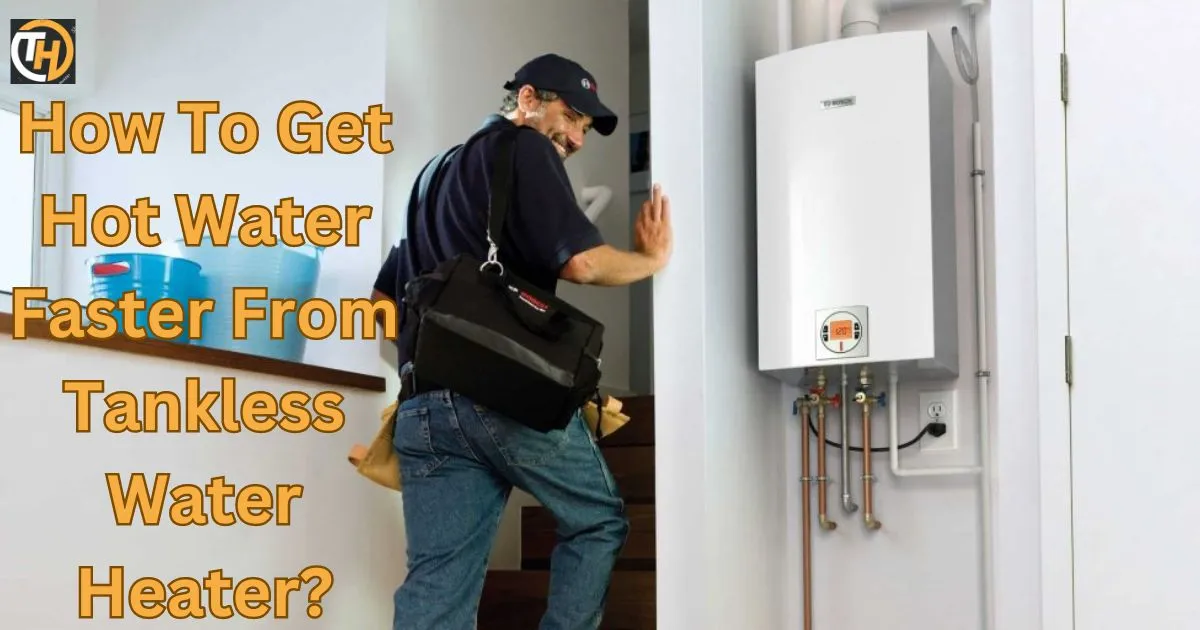Tankless water heaters have gained popularity for their energy efficiency and endless hot water supply. However, there’s one common concern – the initial wait for hot water. Unlike traditional tank water heaters that keep a reservoir of hot water ready, tankless heaters must heat the water on demand. But don’t worry; there are ways to get hot water faster from your tankless water heater. In this article, we’ll explore some effective strategies to minimize the wait time and enjoy hot water as soon as you turn the tap.
Getting hot water faster from a tankless water heater is a common goal for homeowners seeking convenience and efficiency. These innovative water heaters offer on-demand hot water, but there are specific techniques and strategies to make the hot water flow even faster.
In this article, we’ll explore practical tips and solutions to help you get hot water more quickly from your tankless water heater, ensuring that you can enjoy a steady supply of hot water without unnecessary delays.
Location Matters
The location of your tankless water heater is a crucial factor that directly affects how quickly you can get hot water. By placing the unit strategically, you can significantly reduce the wait time for hot water at your fixtures. Here’s a more detailed explanation of why location matters and some tips for optimizing it:
Proximity to Fixtures:
When installing a tankless water heater, consider its proximity to the fixtures where you need hot water the most, such as showers, sinks, and dishwashers. The shorter the distance between the heater and these fixtures, the faster hot water can reach them.
Reducing Pipe Length
Longer pipes require more time for hot water to travel through, and they can lead to heat loss along the way. By minimizing the length of the pipes connecting the heater to the fixtures, you’ll reduce the time it takes for hot water to arrive.
Strategic Placement
When choosing the location for your tankless water heater, take into account the layout of your home. If your bathroom is on one side of the house and the water heater is on the other, it will naturally take longer for hot water to travel. Placing the heater centrally can help distribute hot water more evenly.
Outdoor Installation
Some tankless water heaters are designed for outdoor installation. If possible, consider installing the unit on an exterior wall close to the fixtures you frequently use. This can be especially beneficial if you have a detached bathroom or kitchen from the main house.
Avoiding Remote Corners
Avoid installing the heater in remote or hard-to-reach corners of your home. These locations can lead to longer pipe runs and more waiting time for hot water. Opt for central and accessible areas.
Consider Zoning
In larger homes, zoning can be an effective strategy. Zoning involves using multiple tankless water heaters strategically placed throughout your home, each serving a specific area. This can reduce wait times and energy waste.
Consult with a Professional
To ensure the most efficient placement, it’s advisable to consult with a professional plumber or a tankless water heater installer. They can evaluate your home’s layout and hot water needs to determine the best location for the unit.
In conclusion, the location of your tankless water heater plays a vital role in how quickly you can get hot water. Strategic placement, considering the proximity to fixtures and the length of pipes, is key to reducing wait times and improving the overall efficiency of your hot water delivery system.
Optimize Flow Rate
Optimize Flow Rate
Flow rate is a critical factor when it comes to tankless water heaters, as it determines the quantity of hot water the unit can produce per minute. To get hot water faster from your tankless water heater, you must ensure that the flow rate matches your household’s demand. Here’s how to optimize the flow rate:
Select the Right Flow Rate
When choosing a tankless water heater, it’s essential to consider your household’s hot water demands. If you pick a unit with a flow rate that is too low for your needs, you’ll likely experience delays in getting hot water. To avoid this, carefully assess your usage patterns and choose a tankless heater with an adequate flow rate. A professional plumber can help you determine the appropriate flow rate for your specific situation.
Avoid Undersizing
One common mistake is selecting an undersized tankless water heater. These units may struggle to provide hot water quickly, especially during peak demand periods. Make sure to invest in a unit with a flow rate that meets or exceeds your hot water requirements. It’s better to have a slightly larger unit that can handle your needs without delays.
Consider Peak Usage
Think about the times when your household experiences peak hot water demand, such as during morning showers or when running multiple appliances simultaneously. Your tankless water heater should be capable of meeting these peak demands efficiently.
Check the Manufacturer’s Recommendations
Different tankless water heaters have specific recommendations regarding flow rates for optimal performance. Consult the manufacturer’s guidelines to ensure you’re selecting the right unit for your needs.
Consult a Professional
When in doubt, it’s always a good idea to consult with a professional plumber or an HVAC technician. They can assess your hot water requirements, the number of fixtures in your home, and other factors to determine the ideal flow rate for your tankless water heater.
In summary, optimizing the flow rate of your tankless water heater is essential for getting hot water faster. It involves selecting a unit with an appropriate flow rate that matches your household’s needs and avoiding the common mistake of choosing an undersized heater. By taking these steps, you can ensure that your tankless water heater efficiently meets your hot water demands without delays.
Insulate Your Pipes
Insulating the hot water pipes in your home can help retain heat and reduce heat loss during transit. This means the hot water will reach your fixtures at a higher temperature, allowing you to achieve your desired warmth faster.
Use a Recirculation System
Consider installing a hot water recirculation system. These systems continuously circulate hot water throughout your plumbing, ensuring that hot water is always readily available. While this adds a bit of complexity to your plumbing, it’s a proven method to get hot water quickly.
Set the Right Temperature
Tankless water heaters allow you to set the desired temperature. However, setting it too high can result in a longer wait time. Finding the right balance between a comfortable temperature and a reasonable wait time is essential.
Regular Maintenance

Like all appliances, tankless water heaters need regular maintenance. Scaling and buildup can reduce their efficiency. Be sure to follow the manufacturer’s guidelines for maintenance and flushing your unit to keep it operating at peak performance.
Consider a Buffer Tank
A buffer tank, also known as a storage tank, can store a small amount of hot water, ensuring that some hot water is readily available when you turn on the tap. While this adds to the initial cost, it can significantly reduce the wait time.
Upgraded Technology
If you’re due for a new tankless water heater, consider the latest models with advanced technology. Some newer units are designed to heat water even faster, minimizing the delay.
Be Mindful of Water Waste
While waiting for hot water, you might let the cold water run, which is a waste of water and energy. Collect the cold water in a container, which you can use for other purposes, such as watering plants.
Instant Hot Water Recirculation Systems
Some tankless water heater manufacturers offer instant hot water recirculation systems that provide hot water at your fixtures instantly. These systems are designed to work seamlessly with specific tankless models, significantly reducing the time it takes to fill a water heater and ensuring you have hot water when you need it.
here’s a table summarizing the key points and descriptions from the article on optimizing flow rate for faster hot water from a tankless water heater:
| Key Point | Description |
| Select the Right Flow Rate | To get hot water faster, choose a tankless water heater with a flow rate that meets your needs. |
| Avoid Undersizing | Undersized units may struggle to provide hot water quickly. Opt for a slightly larger unit. |
| Consider Peak Usage | Factor in peak demand times to ensure your tankless heater can handle the maximum load. |
| Check Manufacturer’s Recommendations | Review the manufacturer’s guidelines for flow rate suggestions. |
| Consult a Professional | When in doubt, seek advice from a plumber or HVAC technician for a tailored solution. |
FAQs
How long should it take to get hot water from a tankless water heater?
- The time it takes to get hot water from a tankless heater can vary, but it’s typically quicker than traditional heaters. It can be a matter of seconds to a minute or two.
Why is my tankless water heater not getting very hot?
- Several factors can affect water temperature, such as flow rate, temperature settings, or a malfunctioning unit. Check these aspects to identify the issue.
How can I speed up my hot water?
- You can expedite hot water delivery by optimizing the flow rate, setting the right temperature, and considering the location of your tankless water heater.
Does a tankless water heater heat water faster?
- Tankless water heaters are designed to provide hot water on demand, so they generally heat water faster than traditional tank-based heaters.
Conclusion
In conclusion, while tankless water heaters offer many advantages, addressing the initial wait for hot water is possible with strategic placement, the right unit, and proper maintenance. By implementing these techniques, you can enjoy the benefits of endless hot water without prolonged delay. Remember that the best solution for getting hot water faster depends on your specific needs and your tankless water heater model.
In conclusion, achieving faster hot water delivery from a tankless water heater is possible with strategic considerations. By optimizing the unit’s flow rate, ensuring an appropriate location, and addressing any issues promptly, you can enjoy efficient and timely access to hot water in your household. Remember to match the unit’s capacity to your specific needs to enhance its performance further.











